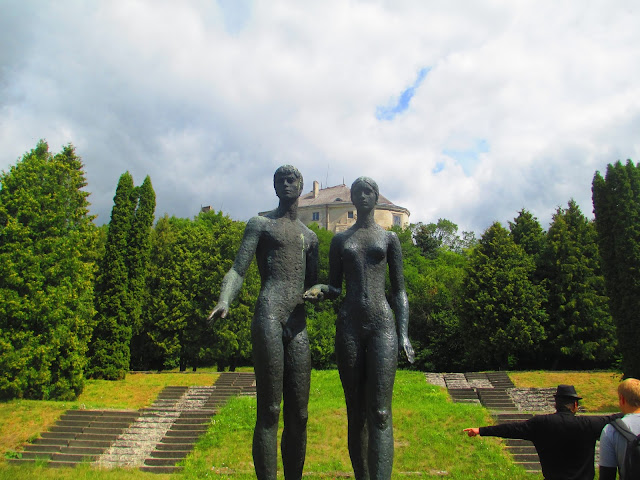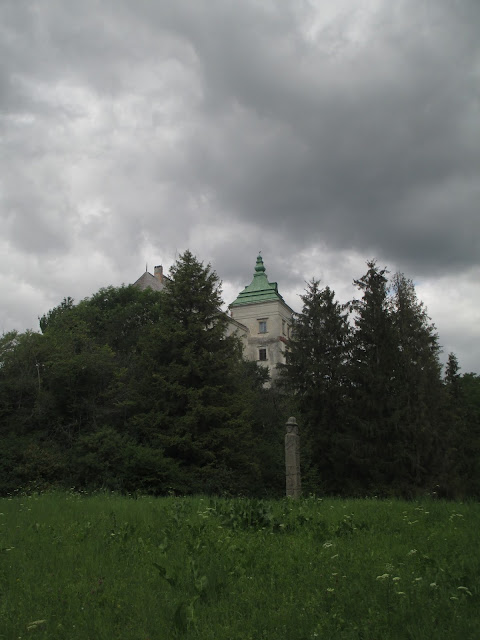So many adventures to catch up with! The last two weekends I've gone on wonderful excursions, some of the best sightseeing I've done in my life :) Last weekend we went to the Golden Horseshoe, a series of three castles north of L'viv which still remain from the Russo-Turkish wars.
The first stop on the trip was the village of Biliy Kamin (White Rock) to watch a potter make the traditional black-fired pottery. The potter even gave everyone a chance to make their own pieces of pottery. And although, as you know, I love love crafts, I was unable to take part because I was wearing nice clothes and my nails were too long. It was still neat to watch the master at work, though.
After the trip to the pottery studio, we headed for the first castle, Olesko Castle. Driving toward it, we saw it from a distance.
A crumbling Benedictine monastery stood across from the castle.
After examining the monastery courtyard, we took the long walk around the castle to enjoy its gardens.
 |
| The view of Olesko Castle from the gardens below |
 |
| The view from the castle |
 |
| An unintentionally sultry selfie I took when attempting to take a selfie with the great landscape in the background :) |
After Olesko, it was on to the next castle: Pidhoretsky Zamok. This castle was the main reason I chose to go on the excursion, since I had already been to the other two castles but not this one. And across from Pidhoretsky Zamok was a church I'd photographed on a previous occasion, not realizing that it was just across the road from this dramatic and stunning castle.
I am always amazed at how quickly things are changing and developing in Ukraine. In particular there is a movement to restore the beautiful Polish churches that have fallen into disrepair. Having been completely arrested by this church the first time I saw it two years ago, and having been told how the Soviets had used it as a repair facility for farm machinery... I was amazed and ecstatic to see that it was finally being renovated, and was open for visitors.
 |
| World War II photographs show the German army using the building |
 |
| The richly decorated interior |
And once we'd visited the church, it was on to the castle. So dramatic and lovely. It's hard to tell whether I like it more than my previous favorite Ukrainian castle (Kam'yanets'-Podilsky) or not.
The castle has yet to be renovated, and simply sits in its state of majestic disrepair. It was last used by the Soviets as a Sanitorium, giving it an even creepier air.
 |
| The view from the castle was incredible. |
 |
| The collapsed front steps are a perfect example of the castle's crumbling appearance. |
 |
| But oh my, what a view. |
 |
| I can't get over the beauty of the Ukrainian countryside. I could have stayed on that hill forever. |
 |
| Could you imagine the view from those windows?? |
And of course, no castle is complete without a creepy dungeon that has its own ghost story. This one involves alchemy.
After Pidhoretsky, it was on to the last castle, Zolochivsky Zamok. This one is smaller, with two parts-- the dwelling of the Polish magnate, and his Chinese Palace which he had filled with mementos from the East.
Again I was fascinated by the changes to the place in the last two years. On my last visit, the place was unfinished. Most of the Chinese Palace was empty, and the courtyard was in disrepair. Now everything had been restored, perhaps even too well.
But, like most of Ukraine, the beauty of this place belies its horrific past. It was converted it into an NKVD prison, and when the Germans invaded the retreating Soviets killed all 600 of the prisoners and left their bodies in the courtyard. The Germans then also used it as a death camp for the Jews of the region. Oddly, only the NKVD prison is memorialized in the museum itself. The Nazi history is visible only in a single plaque on the corner of the palace wall, which was installed by the families of the victims. The way these two dark pieces of history are treated says a lot about the contemporary mentality of Ukraine, and the depth of the scars that still remain from such a horrific past.
But that's what makes studying and traveling in this part of the world so all-consuming. In America we read history books. In Ukraine, the history is all around you, if you know where to look.





















































No comments:
Post a Comment